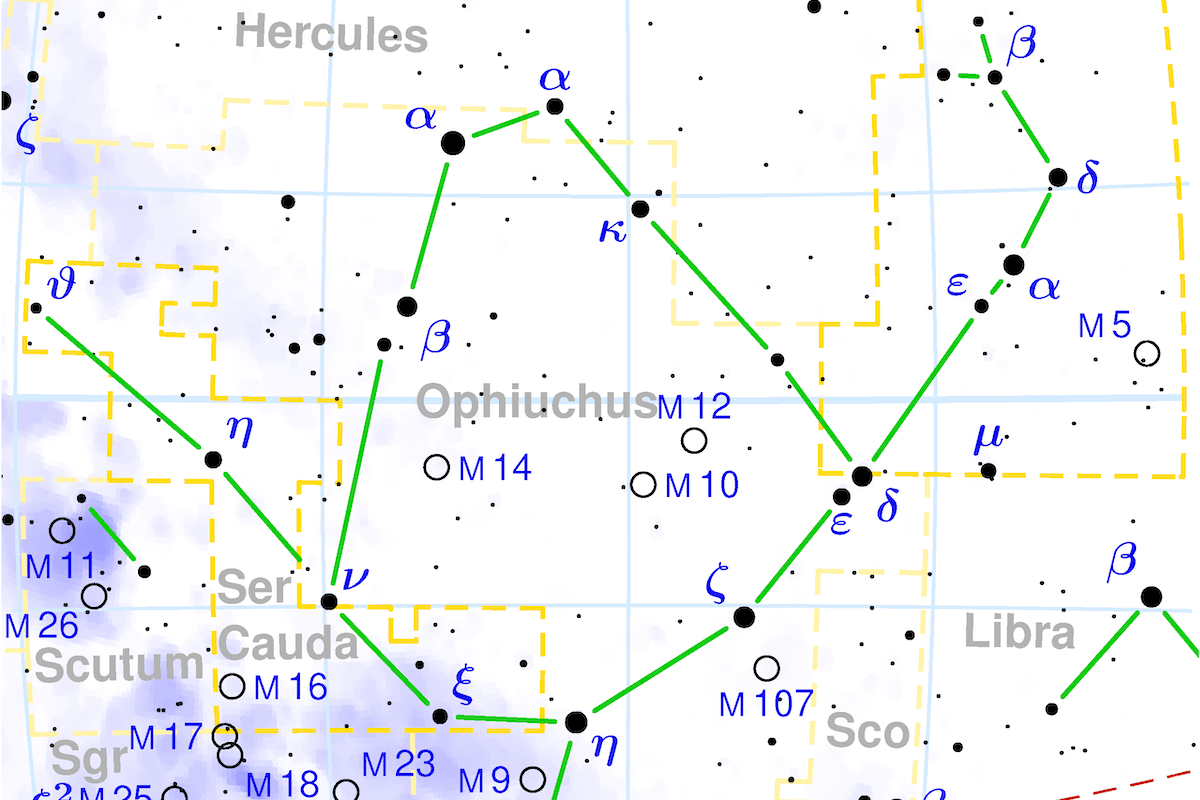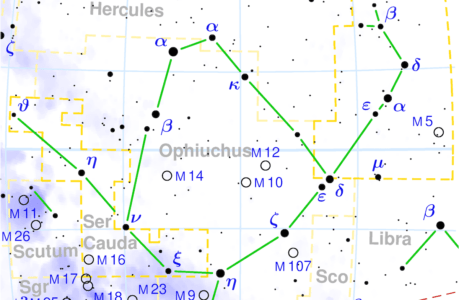The constellation of Ophiuchus has long captured the imagination of stargazers around the world. Located near the celestial equator, it is one of the largest constellations in the night sky, spanning over 948 square degrees of the sky. Its name is derived from the Greek word “ophis,” which means serpent, and it is often depicted as a man holding a serpent in his hands.
For centuries, people have been fascinated by the mystical qualities of this constellation. In ancient mythology, Ophiuchus was associated with the god of medicine, Asclepius, who was said to have the power to heal the sick and raise the dead. It is believed that those born under this sign are intuitive, mysterious, and have an innate understanding of the mysteries of life and death.
While Ophiuchus is not one of the twelve zodiac signs commonly used in Western astrology, it is still considered an important constellation in astrological circles. In fact, some astrologers believe that it represents the thirteenth zodiac sign, with people born between November 29 and December 17 falling under its influence.
If you are a stargazer in Ireland, you are in luck. With its clear skies and relatively low levels of light pollution, Ireland is an excellent place to view the constellation of Ophiuchus. To get started, you will need to know where to look.
Ophiuchus is located near the constellation of Scorpius, which is also known for its distinctive shape and bright stars. To find Ophiuchus, look for the brightest star in Scorpius, Antares, and follow the line of stars that curves away from it. This will lead you to Ophiuchus, which is characterized by its two bright stars, Rasalhague and Sabik.
Once you have located Ophiuchus, take some time to appreciate its unique beauty. With its distinctive shape and bright stars, it is a truly awe-inspiring sight. Take note of its serpent-like form and the way in which it seems to weave its way through the stars.
If you are interested in exploring the mystical qualities of Ophiuchus, there are many resources available online that can help you learn more about this fascinating constellation. From astrology blogs to astronomy forums, there is no shortage of information available for those who want to delve deeper into the mysteries of the stars.
Whether you are a seasoned stargazer or a beginner, viewing the constellation of Ophiuchus from Ireland is an experience that should not be missed. With its unique beauty and mystical qualities, it is a constellation that is sure to capture your imagination and leave you in awe of the wonders of the night sky. So why not grab a blanket, find a comfortable spot, and take some time to explore this fascinating corner of the universe? You never know what secrets you might uncover.
How can I see the constellation of Ophiuchus from Ireland?
If you’re interested in viewing the constellation of Ophiuchus from Ireland, you’re in luck. Ireland’s relatively low levels of light pollution and clear skies make it an excellent place for stargazing.
To find Ophiuchus, you’ll need to look towards the southern sky during the summer months. Ophiuchus is located near the constellation of Scorpius, which is also known for its distinctive shape and bright stars.
To locate Ophiuchus, you can start by looking for the bright red star Antares in Scorpius. Antares is one of the brightest stars in the sky and can be easily spotted on a clear night. From there, look for the curved line of stars that extends away from Antares. This line of stars will lead you to Ophiuchus, which is characterized by its two brightest stars, Rasalhague and Sabik.
Once you’ve located Ophiuchus, take some time to appreciate its unique shape and bright stars. Ophiuchus is often depicted as a man holding a serpent, and its distinctive shape can be easily recognized once you know where to look.
If you want to enhance your stargazing experience, consider visiting one of Ireland’s Dark Sky Parks or Reserves. These areas are designated for their low levels of light pollution and offer some of the best opportunities for stargazing in the country.
Remember to dress warmly and bring along a blanket or camping chair for added comfort. It’s also a good idea to bring a star chart or stargazing app to help you identify the stars and constellations in the night sky. With a little bit of patience and some clear skies, you’ll be able to view the constellation of Ophiuchus and other wonders of the night sky from Ireland.
The mythology of the constellation of Ophiuchus
The constellation of Ophiuchus, also known as the serpent-bearer, has a rich mythology associated with it. In ancient Greek mythology, Ophiuchus was often associated with the god of medicine, Asclepius.
According to the myth, Asclepius was born to Apollo, the god of healing and light, and the mortal princess Coronis. Asclepius was a gifted healer and was known for his ability to bring the dead back to life. This angered Zeus, the king of the gods, who believed that only he had the power to control life and death. As a punishment, Zeus struck Asclepius down with a lightning bolt and placed him among the stars as the constellation of Ophiuchus.
The constellation of Ophiuchus is often depicted as a man holding a serpent, with the serpent coiling around his body. This image is believed to represent Asclepius holding the staff of Asclepius, a symbol of medicine and healing, which is often depicted with a serpent wrapped around it.
In other cultures, the constellation of Ophiuchus has different mythological associations. In Mayan mythology, the constellation was associated with the god Kukulcan, who was known for his wisdom and healing abilities. In African mythology, the constellation was associated with a serpent god who controlled the rain and was worshipped as a symbol of fertility and renewal.
Overall, the mythology of the constellation of Ophiuchus is deeply connected to the idea of healing and the power of medicine. Whether viewed through the lens of ancient Greek mythology, Mayan mythology, or African mythology, the serpent-bearer remains a powerful symbol of healing and renewal, inspiring awe and wonder in stargazers around the world.
The Stars in the constellation of Ophiuchus
The constellation of Ophiuchus contains a number of stars that are visible to the naked eye, as well as many deep sky objects that can be observed with a telescope.
The brightest stars in Ophiuchus are Rasalhague and Sabik. Rasalhague, also known as Alpha Ophiuchi, is the brightest star in the constellation and is located at the head of the serpent-bearer. It is a blue-white star that is approximately 46 light years away from Earth. Sabik, also known as Eta Ophiuchi, is the second brightest star in Ophiuchus and is located near Rasalhague. It is a double star system that is approximately 87 light years away from Earth.
Another notable star in Ophiuchus is Barnard’s Star, a red dwarf that is the fourth closest star to our solar system. It is only 6 light years away from Earth and has the fastest apparent motion of any star in the sky.
In addition to these bright stars, Ophiuchus contains several notable deep sky objects that can be observed with a telescope. One of the most famous is the Barnard 68 dark nebula, which is a dense cloud of dust and gas that obscures the light of stars behind it. Ophiuchus also contains several globular clusters, including Messier 10 and Messier 12, which are groups of thousands of stars that are tightly bound together.
Overall, the stars and deep sky objects in the constellation of Ophiuchus make it a fascinating subject for stargazers and astronomers alike. Whether you’re observing its bright stars or delving into its deep sky objects, there is much to discover and explore in this captivating corner of the night sky.
Deep sky objects visible in the Constellation of Ophiuchus
The constellation of Ophiuchus is home to many fascinating deep sky objects that can be observed with a telescope. Here are some of the most notable ones:
- Messier 9 (M9) – This globular cluster is one of the closest to Earth, located about 25,000 light-years away. It contains hundreds of thousands of stars that are densely packed together.
- Messier 10 (M10) – Another globular cluster, M10 is located about 14,000 light-years away from Earth. It is one of the most concentrated clusters in the Milky Way, containing many bright stars.
- Messier 12 (M12) – Also known as the Gumball Cluster, M12 is another globular cluster in Ophiuchus. It is located about 15,700 light-years away and contains hundreds of thousands of stars.
- NGC 6572 – This planetary nebula is located about 3,000 light-years away from Earth. It is known for its distinctive blue-green color and is sometimes called the “Emerald Nebula.”
- Barnard 68 (B68) – This dark nebula is a cloud of gas and dust that blocks the light of stars behind it. It is located about 500 light-years away and is notable for its distinctive “globular” shape.
- IC 4665 – This open cluster is located about 1,500 light-years away from Earth. It contains dozens of bright stars that are visible even in small telescopes.
- IC 4603 and IC 4604 – These two nebulae are located near each other and are often referred to as the “Rho Ophiuchi Cloud Complex.” They are both emission nebulae, meaning they glow due to ionized gases.

